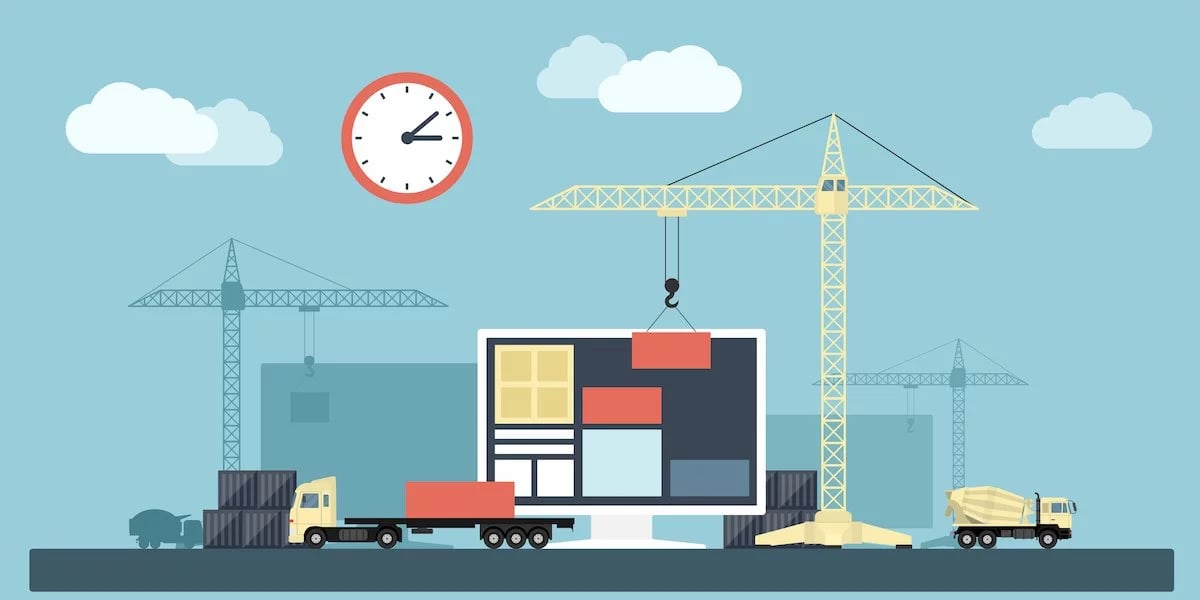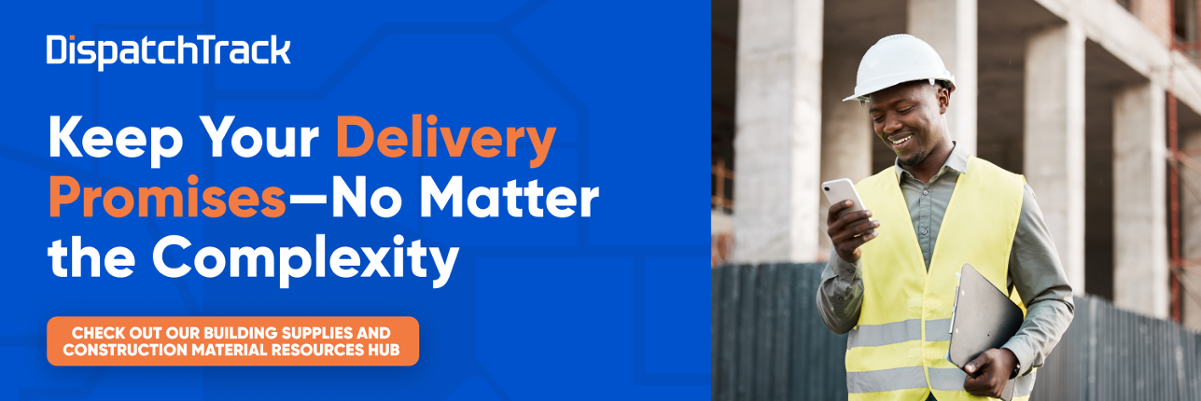Constructing the Ideal Building Supply Delivery Tech Stack
6 Minute Read
Even as the labor market across the country cools off, the latest numbers show that the construction boom—and the increased need for workers that comes with it—isn’t going anywhere. If you’re a construction material supplier, this means that it’s never been more important to find efficient ways to fulfill orders for your customers.
 Unfortunately, efficiency and building supplies distribution don’t always go hand in hand. Most of the time, successful delivery planning means creating order from chaos, which is simply not possible without the right technology tools.
Unfortunately, efficiency and building supplies distribution don’t always go hand in hand. Most of the time, successful delivery planning means creating order from chaos, which is simply not possible without the right technology tools.
When a same-day order for a pallet of lumber comes in, you need to be able to identify that you have the right inventory, find an available driver, select the right (available) vehicle for the job, and schedule the delivery for a time that works for the customer—by the time you’ve gotten that figured out, it’s easy for efficiency to become an afterthought. That’s why it’s not uncommon to see trucks running at half capacity or less in many building supplies delivery scenarios.
Obviously, this isn’t an ideal scenario. You need to keep your customers happy—which means responding quickly to delivery requests—but you also need to make sure you’re using your capacity in a cost-effective way. That’s where the right technology stack can make a huge difference. The question is: what technology actually comprises the best possible tech stack for building supplies delivery?
What Challenges Should Your Delivery Technology Address?
For construction material suppliers, last mile deliveries sit within a complex supply chain that involves a lot of moving parts. And the typical supplier will have a number of solutions in place to address those moving parts, from ERPs and warehouse management systems to business intelligence software and other software systems. Whatever tools you’re leveraging to roll out an efficient last mile process will need to fit in with your existing tools without creating unwanted complexity or producing data and decision-making silos.
At the same time, it’s not just about how your technology fits together—it’s about the capabilities that it provides for your team. To figure out the best approach to rolling out the right technology, you can work backwards from what goes into successful last mile deliveries.
Customer Experience
B2B customers are increasingly expecting B2C-like delivery experiences—a trend that’s becoming a powerful force in the building and construction industries. Not only do contractors and job site managers need fast order turnarounds, they need high-touch delivery experiences with real-time delivery visibility.
To make that happen, your software solution needs to support a host of customer communication capabilities:
- Automated schedule confirmation calls, texts, and emails
- Real-time delivery notifications when items are in transit
- Two-way communication capabilities between customers and dispatchers
- Live, customer-facing delivery tracking via a dedicated portal
- Automated survey links via text and email so you can track your delivery NPS
Whatever solution you’re leveraging should make it easy to send out messages at scale. And it should enable you to configure them as needed, including rolling out different messages for different service types or products.
But it’s not just about the ability to send out messages. You need to provide meaningful visibility into something that’s actually going right. That means showing accurate, up-to-date delivery ETAs in your communications—and then actually executing on those ETAs. To make that happen, your customer experience capabilities have to be closely connected with both your route optimization and your driver management/delivery tracking.
Route Planning and Optimization
If you don’t want to run tracks at partial capacity whenever a last-minute order comes in, you need to find a way to plan routes quickly. More than that, you need to find a way to route your deliveries so that you can be confident about arriving at the right time. When it comes to chaotic job sites, the timing of a given delivery can be crucial to keeping things running smoothly—which means it’s one of the most important keys to keeping your customers happy.
Of course, routing quickly and accurately at scale is inherently challenging. A number of different factors go into ensuring on-time arrivals, including accurately measuring drive time and service time across your routes. Meanwhile, the routing process can be slowed down by poor visibility into available assets and drivers, the complexities of job site delivery requirements, and slow, cumbersome software solutions.
How do you overcome these obstacles? There are two technologies that can make a big difference.
AI and cloud computing.
- Cloud computing: Most on-premise routing solutions slow to a crawl after you throw too many orders at them. Even more modern solutions can take hours to run, meaning that you have to generate routes overnight and adjust them by hand in the morning if there are any changes. But true SaaS building products logistics solutions that are architected to scale help you sidestep that problem. The right solution can route thousands of stops in a matter of minutes—and can adjust existing routes just as quickly. This gives you the luxury of a late order cutoff time and the ability to update routes to incorporate last minute orders without losing efficiency.
- AI: AI and machine have shown a lot of promise in different applications in the past few years, but one of the areas in logistics that they can be most impactful is in improving the accuracy of route optimization. By accounting for all of the factors that impact delivery timing more quickly and effectively than a human planner could possibly accomplish, AI-powered route optimization can help ensure ETAs that are consistently accurate.
When you combine these two technologies you can create routes quickly, adjust them easily, and ensure that you’re delivering to customers at the right time. This then forms the foundation of the B2C-like delivery experience that we were discussing above—including ensuring that customers can get real-time ETA updates.
Visibility and Documentation
There are plenty of reasons why route optimization has historically been hard to optimize, but some of the biggest challenges—not just of routing but of the last mile in general—come down to visibility:
- How do you figure out which drivers and trucks are actually available?
- How do you make sure you have the right inventory in the right depot?
- How do you ensure that you’re routing your trucks to the right place when you’re delivering to job sites that may not have verified addresses?
- Once the delivery is underway, how do you ensure that everything is going smoothly?
- Following the delivery, how do you document deliveries so that you can realize revenue quickly and manage returned items efficiently?
These are important questions for virtually all delivery businesses, but they can be especially important in building supplies distribution. Job sites often have specific delivery requirements (they may require certain vehicle or equipment types, or they may require skilled technicians to perform installations), and large numbers of moving parts can make it difficult to manage same-day delivery requests.
Since over-ordering is fairly common, triaging all of the returned inventory at the end of the day is also tricky—you need a clear record of which products were sent back because of defects vs which ones are fine to be resold.
To grapple with these challenges, your whole tech stack needs to be oriented towards strategic visibility. That means ensuring that the right data is available in the right place at the right time. On delivery day, that might look like live data from drivers as they update their statuses and collect proof of delivery. Before and after, it might mean a single source of truth for delivery operations that enables users to instantly visualize truck and driver schedules, survey responses, delivery audit trails, and much more.
Benefits of Streamlining Your IT with a Single Last Mile Solution
At this point you might have the impression that the challenges that face building supplies distributors in delivery management are all intimately tied up with one another—and you’d be absolutely right. That’s why the ideal delivery management tech stack needs to offer a single solution that deals with these challenges in a holistic way.
Customer experience, route optimization, visibility—and even other activities like reporting and driver management—all impact one another throughout the delivery process. It doesn’t make sense to separate these functions out into different solutions. Rather, the way to ensure a great customer experience without sacrificing efficiency is to streamline your IT, at least as far as the last mile is concerned.
What does this look like in practice? It looks like leveraging a single solution for customer experience, route optimization, visibility, proof of delivery, and driver management. This solution can and should connect seamlessly with your order management system, ERP, and other platforms that you’re currently using, but it should give you the ability to handle the whole last mile from end to end with full visibility without flipping between multiple solutions.
When you can integrate a solution like that, you can turn the chaos of job site deliveries into order and efficiency. More than that, you can delight your customers by consistently keeping your delivery promises.
You may also like
Subscribe now
for a weekly blog digest containing growth tips, industry updates, and product announcements!
